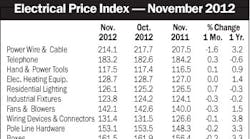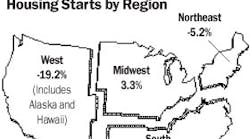Latest from Mag
People - Dec 21, 2012
Obituaries - Dec 21, 2012
November EPI Index Shows No Change
Housing Starts Dip 4% in November
Electrical Marketing - December 21, 2012
Around the Industry - Dec 21, 2012
Just last week, copper hit new highs of $4.62 per pound on the Commodities Exchange (Comex) on Valentine’s Day and $10,190 per metric tonne on the London Metals Exchange (LME) the next day. Based on the fundamental supply and demand picture, many analysts were expecting it to go higher, eyeing the $5 mark. But since then it has dropped back to four-week lows, with the Comex prices down more than seven percent at press time. Where it goes from here is anything but clear.
Electrical distributors, always keenly aware of the copper price and its impact on the value of their wire inventory, didn’t let the drop go unnoticed. One wire manufacturer said in a brief elevator conversation at the NAED conference in San Antonio this week that, predictably, distributors are after him to lower prices on orders they’ve already placed. Can’t hurt to ask.
The market fundamentals of supply and demand have appeared to support continuing increases in prices through 2011, with an expected deficit in LME warehouses of as much as 440,000 metric tonnes, comparable to the shortfall seen in 2010, said John Gross, a copper industry analyst and publisher of the Copper Journal.
Those fundamentals are based on expectations of continuing, though slow, recovery in the countries that consume the most copper.
“The predominant sentiment is bullish, and when it’s bullish the market tends to ignore negative news,” Gross said.
However, sometimes the negative news is big enough that it can’t be ignored. The prospect of oil prices rising back to record levels would qualify as big negative news for the still-tender economic recovery — a recovery that hasn’t yet reached into the construction market that accounts for almost 50 percent of copper use in the U.S.
Developments in the Middle East and northern Africa over the past month raise new doubts about the prospects for that recovery. The unrest that began with the overthrow of governments in Tunisia and Egypt didn’t cause oil investors any heartburn until it spread to Libya, a major oil exporter and OPEC member. The prospect of a disruption to oil supplies there as Col. Gaddafi clings violently to power has pushed oil futures for April delivery up near $100 per barrel this week.
The unstable situation in the Middle East opens the possibility of a significant run-up in oil prices over the longer term, which would have a devastating effect on economic growth throughout the industrialized world and reduce demand for copper.
Not that volatile copper prices are anything new under the sun. In 2008, copper prices hit a new high in July at just over $4/lb, then dropped to $1.25 in just two months as the global recession began to bite. No one then expected the price to come back as quickly as it has, Gross said.
Along the way, the relationship between metals inventories and price has become decoupled, in part because investors use commodities such as copper to offset risks in fluctuating stock prices and currency values. This decoupling “will last as long as it lasts,” Gross said.
The introduction of new exchange-traded funds (ETFs), which are essentially tradable investment vehicles that hold assets in commodities such as copper, adds to the volatility of futures prices by allowing investors to play commodities markets without having to trade in the actual commodity.
China’s recent moves to raise interest rates and shift its economy to one based less on exports and more on domestic consumption have tempered the demand outlook for the world’s largest consumer of copper, but there are indications that this shift may already have been factored into copper pricing. When China raised rates in October, the price of copper fell 10 percent the next day, but subsequent increases in December and February had little discernable impact on the price of copper, Gross said.
All the electrical industry can really do is plan for continued volatility, meaning having strategies for dealing with scenarios where the price of copper is unusually high or low, said Gross. “There is little point in trying to outguess the market, it can’t be done consistently,” he said.

